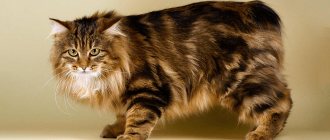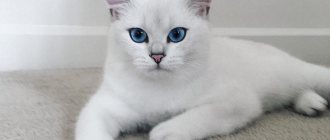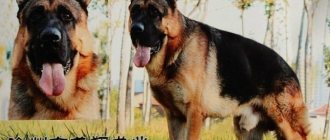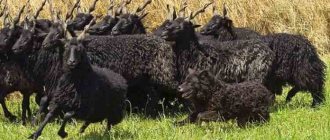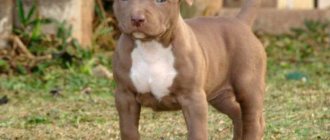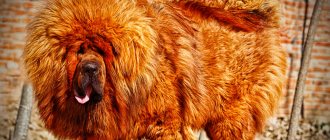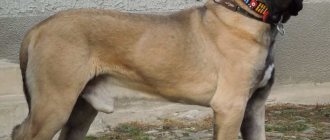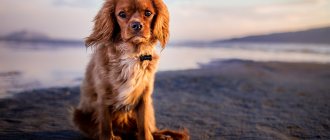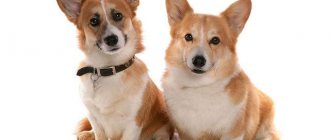Characteristics of the Jagdterrier breed
| Shedding |
| Security qualities |
| Guard qualities |
| Get along with children |
| Get along with animals |
| Exercise stress |
| Training |
| Care |
| Contents in the apartment |
| Agility |
| Homeland: | Germany |
| For an apartment: | Not recommended |
| Fits: | for experienced owners |
| FCI (ICF): | Group 3; Section 1 |
| Lives: | 12 – 15 years |
| Height: | males: 33-40 cm females: 28-36 cm |
| Weight: | males: 9 -10kg females: 7.5–8.5 kg |
The Jagdterrier is a German hunting terrier, a burrowing breed of dog. An excellent watchdog, companion for a hunter and a very active person. Brought out in the 19th century in Germany, it was quite difficult to achieve the desired qualities. The goal of the breeders was to create a universal hunting dog with a dark color. To breed the Jagdterrier and obtain the necessary hunting genes, different breeds were used, such as the German hound, Lakeland terrier, pinscher, dachshund and fox terrier. Considering that the main task was to breed a working breed, the appearance - exterior - was not strictly taken into account.
There are two types:
The quality of a breed is mainly determined by the quality of its performance. In this regard, it must be at a high level. This is a type of burrowing hunting dog. Most often she is taken to hunt fox, wild boar, hare, badger, and waterfowl. It is very popular in Austria and Germany.
History of the breed
The official name of the breed leaves no doubt where this terrier came from. Another masterpiece of German cynology belongs to modern times, its history surprises - what are the possibilities of selection if you take up the matter wisely and with a clearly defined goal.
The idea of getting a more practical and improved version of the fox terrier for hunting arose in Germany before the First World War. Once the difficulties of the post-war period were overcome, work proceeded at an accelerated pace.
Enthusiasts in the southern states of Germany purposefully selected and bred terriers with specified characteristics:
- dark color without spots,
- high malice,
- excellent versatile working qualities.
As soon as the authoritative hunter and dog breeder Dr. Lackner joined the movement, the work got on a clear track, and in 1926 the “German Hunting Terrier Club” began work in Munich. There was no breed as such yet, but the breeders were already developing a general type of new dogs.
It is reliably known about the use of fox terriers, both smooth-haired and wire-haired. The blood of other English terriers was also infused: Manchester, Welsh Terrier, Old English, and several combinations were tried.
By 1934, the main provisions of the new breed standard were drawn up. The livestock with a distinct breed type reached the required level of 200 animals, after which the club received permission from the German canine service to maintain its own stud book.
As a result of the combined efforts of several breeders, already 15 years after its founding, the club considered the work of developing a new breed completed. But we had to return to it - the Second World War began.
It took much more than 15 years to restore the population and general type of the Jagd Terrier. True, modern German breeders approached the issue with maximum rigor and meticulousness. They considered it possible to register the breed with the FCI only in 1954.
The club's work continued purposefully in the western part of Germany. Different types of dogs, but very useful for hunting, also became widespread in the eastern sector - in the GDR - and in Czechoslovakia. From there, a few representatives of NOTs were brought to the USSR.
A qualitative leap in the breed occurred in the 80s, when the consolidation of the exterior type of NOT was completed, undesirable character traits were eliminated and a system of comprehensive working tests was developed. Soon after the fall of the Iron Curtain, a variety of breeding material became available in the CIS countries, and the Jagd Terrier entered the list of the most numerous hunting breeds in the European part of Russia, as well as in Belarus, the Baltic states and Ukraine.
Description of the German Jagdterrier breed and FCI standard
- Country of origin: Germany.
- Purpose: a versatile hunting dog with high performance, especially effective for burrow hunting, has proven itself well as a dog for raising animals.
- FCI classification: Group 3. Terriers. Section 1. Large and medium sized terriers. With performance tests.
- Important proportions:
- ratio of the chest circumference to the height of the dog at the withers: chest circumference is 10 - 12 cm greater than the height at the withers.
- The length of the body is slightly greater than the height at the withers.
- The depth of the chest to the height at the withers is approximately 55 - 60% of the height at the withers.
- General appearance: small, compact, well proportioned hunting dog, predominantly black and tan.
- Behavior/Temperament: cheerful, temperamental, courageous, courageous, efficient, hardy, loyal, easily controlled; never timid or aggressive.
- Head: elongated, slightly wedge-shaped, non-pointed muzzle slightly shorter than the skull.
- Skull: flat, wide between the ears, narrower between the eyes.
- Stop (transition from forehead to nose): weakly expressed.
- Nose: The nose is black, should not be too narrow or too small, and not split. With a basic brown coat color, a brown nose is acceptable.
- Muzzle: strong, with a clearly defined lower jaw, strongly pronounced chin.
- Lips: Tight fitting, well pigmented.
- Cheekbones: well defined.
- Jaws/Teeth: The jaws are strong with a regular scissor bite, the upper row of incisors overlaps the lower row without gap, the teeth are set perpendicular to the jaw. The teeth are large, a complete dental formula of 42 teeth must be present.
- Eyes: dark, small, oval, positioned in such a way that they are well protected from damage, eyelids tightly fitting, determined look.
- Ears: Set high, not too small, triangular in shape, slightly raised on the cartilages, slightly lying ears with a fold.
- Neck: strong, not too long, well set, harmoniously flowing into the shoulders.
- Withers: well defined.
- Topline: straight.
- Back: strong, level, not too short.
- Loin: muscular.
- Croup: Well muscled, horizontal.
- Chest: deep, not too wide, with well-spreading, curved ribs; The chest bone is long.
- Underline/Belly: Gracefully curved, short and tucked crotch, belly slightly tucked.
- Tail: well set on a long croup, docked by 1/3, when the dog grabs prey in a hole, the owner can pull it out of there by the tail. The tail is carried slightly raised, but should never be carried over the back.
In countries where tail docking is illegal, the tail may remain natural. It is held horizontally or saber-shaped.
Note: Males must have two apparently normal testes fully descended into the scrotum.
Pros and cons of the breed
The Jagdterrier is completely focused on hunters, and has many admirers in this community. What do they value in the breed:
- Versatile performance qualities.
- Small size is good for city dwellers.
- Low maintenance costs.
- Perseverance and determination.
- Activity, liveliness and intelligence.
Important! Not suitable as a dog for children or as a companion.
Even from the point of view of many hunters, the breed is not without its disadvantages:
- Too hot and "explosive".
- Often injured.
- Likes to sort things out with dogs and chases cats.
- Requires constant supervision during walks.
Despite the difficult nature of Jagdterriers, their numbers are growing. An increasing percentage of dogs have adequate, civilized behavior and noble appearance. The breed has a future.
GREENLAND DOG: HISTORY OF THE BREED AND CHARACTER OF THE DOG
BOXER DOG: HISTORY OF THE BREED AND CHARACTER OF THE DOG
ST BERNARD: HISTORY OF THE BREED AND CHARACTER OF THE DOG
Dwarf Pinscher: HISTORY OF THE ORIGIN OF THE BREED AND CHARACTER OF THE DOG
Character of the Jagdterrier (German hunting terrier)
The character of the Jagdterrier is quite complex. He is brave, fearless, vigilant, but often very stubborn. This is a hurricane of energy and a perpetual motion machine; even in adulthood it remains a fairly active dog.
The Jagdterrier has good health, gets along well with children, is affectionate and playful, unpretentious in food and care, a good guard, an excellent hunter, and tolerates long journeys well. In relation to strangers, the dog is often aggressive and is suitable as a guard dog.
If you want to buy a Jagdterrier, remember that this is not a breed that is kept as a pet that will snore peacefully on the sofa.
First of all, this is a hunter dog, and the desire for freedom is in its blood. Therefore, her character is appropriate; she does not like a quiet lifestyle at all. The Jagdterrier has a subtle sense of smell and pronounced courage. They are very aggressive towards animals, they can attack neighbors’ cats, dogs, and hunt poultry; an instinct that has been laid down by nature for decades is almost impossible to overcome. But timely training and strict upbringing can slightly restrain the frantic energy of the Jagd Terrier.
Sometimes they are aggressive towards people, but this is primarily a problem in their upbringing. Therefore, to acquire such a breed should be a person with a strong character, knowledgeable in dog training, or an experienced hunter who can use the animal for business and strictly educate it.
The Jagdterrier treats its owner with devotion and respect. Recognizes only one owner. With proper training, the dog is obedient and restrained.
Features of character and temperament
Because of his explosive temperament, Yag is called “dynamite.” His character must be assessed both in terms of hunting qualities and his social adaptability. He is, first of all, an assistant to the owner on the hunt. Therefore, its hunting qualities, for which the breed was bred, should be considered first.
The best owner for a yag is a hunter. The characteristics of the Jagd Terrier breed can be expressed by several qualities:
- Fearlessness and tenacity in pursuing the beast;
- Independence;
- Absolute devotion to his master;
- Discipline and precision in completing the assigned task while hunting.
From an early age, jags show their extraordinary character. In describing the Jagdterrier breed, many breeders point to its personal characteristics. Aggression towards other animals is inherent in them at the genetic level and the owner of such a dog should always remember this. Jagd tries to become a leader not only among his own kind, but also among family members, including the owner. And if he is given slack, then it will become simply impossible to cope with a hunting dog that can use its teeth. Therefore, if you want to have an excellent hunter in the person of a Jagdterrier, you must keep in mind that in his upbringing he needs a firm hand and a stronger will than he himself has. A Jagd who recognizes his master and unquestioningly obeys him will become a family favorite, disciplined and adequate.
When introducing animals into the house, you need to know that there should no longer be other animals there. These dogs do not tolerate either cats or birds due to their very jealous attitude towards their own person, as well as due to a very developed hunting instinct.
Keeping a Jagdterrier as a watchdog is also risky. He is adequate in the role of a watchman until someone gets in his way, in his understanding - “game”. It could be a cat or someone else's dog, or even uninvited guests who showed up without an invitation.
This is the complex, quarrelsome character of this small, seemingly unremarkable Jagdterrier dog, the photo of which you see. Therefore, the most important thing for representatives of this breed is proper upbringing, giving them a lot of time and effort - physical and mental. Then they make both wonderful hunters and loyal friends. Maintenance and care
Jagdterriers are unpretentious to living conditions. Important points in caring for these dogs are careful grooming and prevention of helminth infestation. The fact is that Jagdterriers have to deal with wild animals that are infected with helminths and can transmit them to the dog. In addition, a hunting dog must be promptly vaccinated against dangerous infections.
Jagdterrier care
Caring for the Jagdterrier is very simple and does not require much attention. But for the health of the dog, you should take care of its fur, ears, eyes and paws.
It is advisable to bathe the German Jagd Terrier as needed, using shampoo for short-haired breeds.
After bathing, dry the fur and ears well with a towel, you can use a hairdryer, make sure that the animal is not in a draft. After bathing, you are allowed to walk 2 hours later (in the warm season, in winter, bathe the dog at night) when the ears and fur are completely dry. To speed up the drying of your Jagdterrier's ears, insert cotton wool into the ears and it will absorb excess moisture.
Wool must be combed with a special natural hair brush or rubber mitten once a week. The wool will gain shine, be cleared of dust, and will not tangle.
Ears should be examined and checked regularly. Remove dust and wax from the ear canal with a damp cloth.
Ticks and fleas on the Jagdterrier: Regularly treat the Jagdterrier with products against ectoparasites (ticks, fleas, lice eaters). These little bugs pose a great threat to health and life.
Photo of Jagdterriers in the forest
Drops are applied to the area between the shoulder blades, closer to the dog’s neck so that it cannot lick it off. Do not bathe for 10 days, do not allow children to be ironed for 24 hours. Considering that the dog is a hunter, often in the forest, running through bushes and dry grass, there is a huge risk of picking up a tick. Very often they are found in the ears, on the neck, under the arms, and on the chest. After a walk, be sure to inspect the entire pet, remove the tick if one is found, and treat the affected area with iodine or hydrogen peroxide.
Maintenance and care
By creating the Jagdterrier, German dog handlers set a record: they created a dog with minimal grooming requirements. Jags are democratic and unpretentious, do not complain of appetite, but do not overeat, and feel good both in an enclosure and in a city apartment.
The only maintenance problem is walking.
Yes, when it is necessary to provide serious physical activity, regular and, moreover, emotional. Even during the hunting season, when going out into the grounds for 1–2 days a week, the dog regains its strength very quickly. Only sports and active games with the owner can distract the dog from searching for adventure.
In the off-season, the Jagdterrier becomes bored. This is a little dangerous, the dog needs to “let off steam” from time to time. Swimming, summer cottages and long hikes in the surrounding area are recommended.
The nature of the breed does not allow keeping same-sex dogs in the same area (in an apartment); when distributing between enclosures, pairs and neighbors should be selected carefully. At the same time, when hunting, dogs of the same owner interact well.
For transporting dogs in a car while hunting, the best option is wooden or plastic boxes.
Terrier hygiene is simple: washing with shampoo no more than once every 2-3 months, brushing the coat a couple of times a week. When keeping apartments, it is easy to clean by wiping with a towel and changing the bedding. It is convenient to use powdered dry shampoo.
If the puppy’s coat is not sufficiently hard and elongated, it is recommended to trim it 1-2 times in the first year to improve the structure.
Considering the “occupational” risks of NOT, at home and when hunting, it is better for owners to have a specially selected first aid kit for treating wounds and washing eyes.
Jagdterrier content
In the photo there are Jagdterrier puppies on a lounger
A country house with a spacious enclosure would be ideal for keeping a Jagdterrier. This is an active and lively dog, which definitely requires a lot of long walks, even when kept in an enclosure. During walks, it is advisable to load the Jagdterrier with active games, long runs, and training.
The Jagdterrier is raised from early childhood, when the puppy is 3-4 months old.
The breed is smart and quick-witted, and quite quickly begins to understand the owner and follow his commands. It is very good to use the imitation method. If possible and desired, an adult trained dog should be nearby, then the Jagd Terrier begins to follow its example.
During training, he should feel that the owner is dominant. Rigidity cannot be used in training, but at the same time, instructions must be firm, precise and persistent. If the Jagdterrier does not like the training methods, she will show it and be stubborn and disobedient. With improper and cruel upbringing, the dog can become uncontrollable or too aggressive, therefore, great attention should be paid to training. If the upbringing is correct, the Jagdterrier becomes a very devoted, friendly and obedient pet.
When keeping a Jagd Terrier in a city apartment, the owner must take into account all the needs and disadvantages of the breed:
- Be sure to take a walk, 2 times a day, 1 - 2 hours.
- Moving, active walks with elements of training
- Don't let him off the leash; he might throw himself in front of a car.
- Hunt all living things for the rest of your life, get ready for unpleasant surprises (attacks cats, birds, strange dogs)
- May run away from home, or on a walk
- Left alone at home for a long time, he can damage property (chew slippers, toys, wires, etc.)
- Don't feed before going for a walk
- Work out on the playground, attend frisbee and agility training
Jagdterrier food, menu for a puppy
In the photo there is a Jagdterrier puppy with a stick
You can feed your Jagdterrier with dry professional food or natural food. If this is the second option, then it is necessary that the diet should be dominated by porridge, meat, and vegetables. Be sure to have clean water available for drinking.
Products necessary in the Jagd Terrier's diet:
- Beef, beef broth (it’s better not to give veal, it’s difficult to digest and can cause diarrhea)
- Various offal, chicken, turkey, beef
- Dairy products:
- low-fat cottage cheese up to 9% fat, otherwise give your pet a liver)
- kefir
- natural yoghurt, no dyes
- curdled milk
- puppies up to 3 months, milk
- Porridge: buckwheat, millet groats, rice (for diarrhea), oatmeal
- Cartilage as a delicacy
- Seasonal vegetables and fruits
Jagdterrier: feeding a puppy
Menu for a Jagd Terrier puppy, feeding time and frequency:
Puppy 1 - 2.5 months:
- 8 o'clock - milk with curdled milk and a little honey
- 11 o'clock - rolled oats, pre-soaked overnight in milk, kefir, broth
- 2 p.m. - raw beef scalded with boiling water, boiled sea fish with raw vegetables, finely grated carrots, with vegetable, sunflower, soybean, or corn oil
- 17 o'clock - low-fat cottage cheese, or milk with honey (1 teaspoon per glass, can be with rolled oats, buckwheat)
- 20 o'clock - main feeding: raw meat, scalded with boiling water, with the addition of 0.5 teaspoons of vegetable oil. Chopped seaweed, half a teaspoon of finely chopped seasonal greens: lettuce, parsley, celery, dandelion leaves, young nettle, wild mint.
- twice a week yolk, dip raw meat into it.
- add garlic to meat and broth 2 times a week
Jagdterrier puppy 2.5 - 4 months:
- Feeding hours are 8, 12, 16 and 20 hours.
- Be sure to give meat and fish in the last two feedings
- Distribute milk, kefir, cereals and vegetables between morning and afternoon feedings.
- Increase the amount of meat additives to 1 - 1.5 teaspoons, depending on the weight of the dog.
A puppy older than 4 months of age is fed three times a day: at 8, 14 and 20 o'clock. Increase the amount of food and give meat with additives in the last - main feeding.
Feed a puppy after 8 months and an adult dog 2 times a day.
- In the morning cottage cheese, porridge, vegetables
- In the evening, meat or fish with additives
Content issues
The German Jagdterrier does not require daily care: short, seasonally shedding coat, natural constitution, small size. They are rarely bathed, as their coarse wool perfectly repels dirt and moisture, cleaning itself.
The main nuances of the content relate to behavioral problems. According to its characteristics, the German Jagd Terrier is hardy and active, which requires regular walking and physical activity. If a dog realizes its natural passion for hunting, at home it is a calm, non-conflict dog - it does not spoil things, does not attack family members, and is indifferent to children.
The absolute opposite is the “couch variety”. Due to its size and pleasant appearance, the breed is often considered as a pet, along with Jack Russells and Foxes. This attitude usually ends quite sadly - a destroyed apartment, bitten guests and neighbors.
If the owner is inexperienced, the dog can terrorize everyone in the household, even children. Cases when a sofa yagd lives attached to a radiator while the owner is not at home are not uncommon.
Even well-mannered pets do not get along well with cats and small animals - birds, rabbits, mice. In most cases, an attempt to suppress the excitement of hunting leads to nothing but the death of a natural hunter's prey.
The Jagdterrier is also rarely tolerant of other dogs - it starts fights, constantly provokes conflicts and can kill a clumsy opponent (even if he is many times larger). But with the proper experience, especially if the dogs are of different sexes, it is possible to achieve neutrality or friendly relations within the pack.
Jagdterrier diseases
The Jagdterrier is the healthiest breed in the world. Throughout his life, he only receives injuries while hunting.
Of course, he can get sick, like any animal, but the advantage of the breed is that there are no hereditary diseases. Symptoms resembling the disease appear only when the owner’s care is insufficient.
Be sure to regularly take anthelmintic prophylaxis (once every 3 months) when in contact with wild animals, this is only a procedure to protect your health. Do not forget to vaccinate your Jagdterrier on time; rabies vaccination is required by law. The specific life of a Jagdterrier or any hunting breed is such that it is often at risk and can even become infected with a disease that is not typical for dogs.
You notice that the dog is sad, inactive, sleeps a lot, refuses to eat, be sure to show your pet to the veterinarian. The specialist will make a diagnosis and prescribe treatment, the main thing is that it is timely.
Health and illness
As for diseases, the Jagd Terrier is perhaps one of the healthiest dog breeds. Of course, injuries during sports or hunting cannot be ruled out, and like any other dog, the German hunting dog can contract infectious and other diseases.
However, unlike many other breeds, this breed does not have breed-specific genetic diseases that lead to certain predispositions. And this gives confidence that such a pet can have very good health and live a long time.
Answer
The German Jagd Terrier is one of the healthiest dog species in the world. If the dog shows signs of illness, this is a result of improper care and nutrition, lack of communication and attention from the owner.
Dogs are required to take preventive measures to prevent helminthiasis. The animal is able to come into contact with other infected pets. Deworming is a necessary condition for a healthy lifestyle and well-being of the Jagd Terrier. It is recommended to carefully monitor the vaccination calendar. Vaccination against rabies is recognized as mandatory in accordance with current legislation.
If your pet becomes sad, inactive and clumsy, it is necessary to conduct a full examination by a doctor in order to promptly recognize and prevent a serious pathology. The doctor will order an examination, establish an accurate diagnosis and prescribe effective and safe treatment for your pet.
Regular examination in a veterinary clinic is considered correct.
Origin story
This breed was bred in the 30s of the 20th century in Germany. The breed standard was first adopted in 1934. The purpose of creating the breed was to create dogs that would be intended for hunting, while very little attention was paid to appearance. Initially, breeders decided to create a breed that would be unpretentious in care and would not encroach on participation in exhibitions.
The ancestors of the German Jagdterriers are fox terriers - tireless game hunters. Looking at photographs of Jagdterriers and fox terriers, the external similarity of the breeds is obvious. But there are also distinctive features - the Jagdterrier breed standard implies a black and tan color, sometimes with small splashes in the chest and paws, while fox terriers have a predominantly white color interspersed with red and black markings. In addition, Jagdterriers are somewhat larger than their ancestors in size and weight. But dogs of both breeds are excellent and uncompromising hunters, although the main characters of this article take the lead - they are the most fierce hunters. In addition to Fox Terriers, Old English Terriers and Welsh Terriers participated in the formation of the breed.
German hunting terriers appeared in the USSR in the 1970s. Thanks to their unpretentious maintenance, small size and excellent hunting skills, Jagd Terriers quickly gained popularity among hunters in the Soviet Union.
How many times a day should you feed your German Jagd Terrier?
To assess the correctness of nutrition, the frequency of daily feedings of the pet is of great importance. If the puppy has not reached four months, feeding is done at least four times a day. A dog's diet in the first months of life certainly includes meat products, chicken and quail eggs, and low-fat, seedless fish. It is possible to feed the puppy dairy products, boiled or steamed vegetables in the form of puree.
Starting from six months, it is allowed to switch to three meals a day. At this age, the puppy’s set of baby teeth is replaced. Puppies begin puberty at six months. The nature of nutrition for a young pet is especially important.
A pet is actively growing up to a year old, the need for food is constantly increasing. The amount of food should be increased gradually. Meat and meat products are recognized as an essential part of a hunting dog’s diet. When the pet reaches the age of 9 months, the dog is transferred to an adult diet - twice a day.
Training and education
Training of German hunting terriers should begin from 6-10 months of age, depending on the character of the animal, the degree of trust in the trainer, and the developmental characteristics of the dog, the process can take at least six months. Training is carried out twice a day for 1 hour - in the morning and in the evening, before eating or a few hours after. It is desirable that the dog trusts the trainer; for this it is necessary to establish contact between the person and the animal.
The main goal of training is to give the dog hunting skills. Training and training of Jagdterriers is based on methods of excitation and inhibition of the animal’s nervous system. You should never overload an animal by trying to teach it many commands at the same time. If training in elementary commands can be carried out if desired by an inexperienced owner, then complex skills must be instilled by a specialist (or at least under his supervision, on his advice). To do this, it is advisable to find a hunting dog breeding club where you can count on assistance in training.
Experienced instructors will talk about the intricacies of the training process for such dogs. The advantages of joining such a club are not only the availability of specialists, because they will also provide a training ground, which is especially important for those owners who do not have the opportunity to train their dog daily in the fresh air, away from the trails, over a large area. It is worth remembering that training these dogs is mandatory. An untrained (or improperly trained) Jagdterrier becomes uncontrollable, overly aggressive, threatening the life and health of people and animals.
What to feed a Jagdterrier
Remember, when you skimp on food for your four-legged friend, you risk ending up with a sick animal.
- Meat and meat products. The dog of the mentioned breed absorbs beef broths better than anything else. It is unacceptable to feed your dog boiled veal. The animal develops indigestion and diarrhea.
- Offal. German terriers really like this type of food. It is acceptable to use chicken, turkey, and beef by-products.
- Milk and dairy products. It is recommended to give cottage cheese to your pets daily. Fat content does not exceed 9%. A fattier product will have an adverse effect on your pet's liver. It is acceptable to feed the dog kefir, yogurt, and unsweetened yogurt. If you give milk - low-fat, no more than 1%.
- Porridge for pets is made from buckwheat, oatmeal, rice, and millet. Remember, some pets develop constipation from rice porridge.
The issue of feeding dry food remains open. This type of feeding has supporters and opponents. If you decide to resort to dry food, remember that the dog needs to be provided with a sufficient amount of clean drinking water.
Dog food
Jagdterriers do not require a special balanced diet - you can choose dry food for this breed or prepare nutritious porridge for it yourself.
The diet of an adult dog may consist of buckwheat or wheat cereals with the addition of beef broth and cartilage. You can add slices of seasonal vegetables to your porridge to provide your dog with the necessary vitamins. The Jagdterrier should sometimes be given a little low-fat cottage cheese or kefir, and warm milk is suitable for puppies of this breed.
Dog puppies up to 2.5 months need to be fed 5 times a day ; the daily diet should include light cottage cheese, room-grown milk with a spoonful of honey, pieces of meat in broth or simply scalded with boiling water, plus some greens like parsley or lettuce.
Older Jagdterriers (up to 4 months) eat 4 times a day , but they already have an almost adult type of diet with cereals and various vegetables. You can give some warm milk in the morning or evening.
Yagdas from 4 months already eat 3 times a day , but from the age of 8, the dog’s nutrition is reduced to 2 times a day with the standard recommended list of products for consumption, which were already listed above.
What is not recommended to feed your pet?
In addition to healthy foods for dogs, we will name a list of foods that are not recommended for feeding the German Jagd Terrier.
- You should not give your pet veal tongue to avoid diarrhea.
- It is strictly not recommended to feed your dog beef lungs and udders. Products do not carry nutritional value when passing through the digestive tract in transit.
- It is not advisable to give fatty milk to your pet. It is acceptable to give 1% milk if the dog is not gaining weight well.
- It is strictly not recommended to give semolina porridge to your animal. The dish is not digested by dogs' intestines and can lead to digestive disorders.
It is forbidden to give your pet raw river fish, fatty pork and other fatty meats. Sausage and sausages also have an adverse effect on the animal’s digestive tract.
Do not offer your dog potatoes or legumes. The products are not absorbed in the body and do not bring benefits. White bread, pasta, sweets, spices will harm your pet and lead to the development of allergic reactions.
How much does a Jagd Terrier puppy cost?
Despite the fact that the breed is not very widespread in the territory, there are kennels breeding these dogs in large cities. Experts do not recommend purchasing puppies from random sellers, since in addition to the risks of getting a non-purebred pet, there is a possibility of buying a puppy with behavioral abnormalities and genetic disorders.
In addition, professional breeders necessarily take care of the working qualities of their charges. The cost of purebred babies with documents varies from 15,000 to 30,000 rubles. The lower price should be a concern.
The German Hunting Jagdterrier is a pet that is not entirely suitable as a sofa companion. This dog is intended for hunting, participating in competitions and other active events. In addition, he needs mandatory training and education, and an owner with a strong hand. Otherwise, the dog will be uncontrollable and cause a lot of trouble. If such difficulties do not frighten you, then you can safely go for a new family member.
Video
Yak Terrier: caring for the Jagd Terrier, photo of the dog
The family of hunting dogs includes many interesting breeds, including Jagdterriers. These not very large dogs are often purchased for keeping in urban environments. However, making such a decision is a big mistake, since Jagd Terriers were created for completely different purposes.
In principle, these dogs can live in an apartment, but this step can only be taken in the most extreme cases. When choosing these dogs, you need to remember that they are very active, so they need to be constantly on the move. Therefore, if hunting is not on your list of favorite activities, then give up in favor of another breed, otherwise the Jagd Terrier will feel like it’s in a cage in your apartment.
Jagdterrier puppies: characteristics of the breed
The history of the appearance of this breed is shrouded in mystery. In those distant years, when these dogs were not so popular, people treated them differently, because then there was an opinion that taking light-colored dogs for hunting was a big mistake . It was all about a belief: hunters believed that dogs with light hair would scare away forest spirits, and the hunt would be unsuccessful. Because of this, they did not favor light-colored dogs too much, often choosing darker relatives instead.
However, gradually people began to have a different attitude towards otherworldly forces, however, the hunters were still adamant, so even after many decades they did not dare to trust light-colored dogs . At a certain point, breeders had the idea of bringing a special breed of dark-colored hunting dogs. This led to the appearance of the Jagdterrier.
The only difference between the two types of terriers is their coat. The main feature of wire-haired dogs is the presence of slightly elongated hair on their paws, as well as a beard.
Because of this, people who
Source
Raising a Jagdterrier puppy
So it happened! A purebred Jagd Terrier puppy with an ideal pedigree, confirmed by one of the best kennel clubs, crossed the threshold of his owner. Now it depends only on the latter who will grow from the baby: a professional hunter and obedient companion or an aggressive individual of little use for tracking.
It must be said that Yagda’s character is quite capricious. Therefore, from the first days of his life it is necessary to instill in him the habit of obedience. You should not give in to slack under any circumstances. Although, in many cases it is difficult for owners to do this. The charm inherent in the “young” age of the yagdt confuses them. It will take months to correct the mistakes made.
You should not postpone the hunting training of a Jagd Terrier puppy until the time comes to take the puppy to the training base. It is advisable to instill the relevant skills long before this significant event.
In the puppy’s habitat, you can arrange a real training ground with artificial holes and bait in the form of his favorite toys. Let the little yagd watch how the object disappears into the earthen depression, and then tries to turn the “hole” around and pull the toy out. You can come up with a huge number of ways to do this kind of training at home.
Jagd by nature is a born leader. Finding himself among a pack of dogs, he will fight to the last to prove his right to the territory. However, a yagd can defend its property not only from its relatives. People may also be targeted. Therefore, raising a Jagdterrier must necessarily include developing in the dog an idea of the boundaries of the territory where it can behave like a mistress.
After the yag has mastered the rules of behavior when detecting artificial burrows, you can try to make a test run
Source
Dog appearance (standards)
Photo: https://www.flickr.com/photos/lightdescribe/33956457278/
Dimensions
An adult burrow dog has a height of 33 to 40 cm and a weight not exceeding 12 kg. Bitches are usually a couple of kilograms lighter than males.
Wool
There are two types of Jagdterrier dogs: smooth-haired and wire-haired. Representatives of the first type have coarse, smooth hair and give the impression of neat pets. At the same time, wire-haired dogs with thick and coarse hair resemble disheveled dogs with a beard and eyebrows, as well as longer hair on the belly and paws.
Both types have a well-developed undercoat.
Colors
The most common colors are:
- black and tan;
- brown and tan;
- black and tan with graying.
Head
Dogs have a long head, slightly wedge-shaped.
Teeth and jaws
Powerful jaws, large teeth in the amount of 42 pieces, correct scissor bite.
Eyes
The eyes are oval shaped and dark in color. They are small and deep-set.
Body and limbs
The body of the animal resembles a square. The dog stands out for its massive and short back, rather deep chest and tucked belly.
Limbs straight and parallel. The front ones are located under the body, while the rear ones are slightly pulled back.
Tail
The dog's tail is horizontal or saber-shaped.
The tail cannot be carried over the back.
In most countries, the tail is docked by 1/3 so that the owner can, if necessary, pull the reckless hunter out of the hole.
Rock defects
Serious disadvantages include the following:
- narrow jaw;
- pointed muzzle;
- shallow bite;
- light or bulging eyes;
- hunched back;
- short back;
- twisted elbows;
- hanging or tilted on the back;
- shorthair.
How to choose a puppy
Jagdterrier puppies are similar to their ancestors; when choosing a puppy, you should get to know the parents.
Familiarity with working qualities, living conditions, mental characteristics, health and appearance is of great importance. If you want to buy a reliable hunting assistant, you have to choose from competition participants and exhibition winners. Puppies must look well-fed, active and energetic. If a puppy looks lean before one year old, it is possible that the baby was not treated for worms, this is a bad sign. A thin pet's bones can grow incorrectly; restoring the skeleton to the correct position is extremely difficult.
If the puppy tries to actively escape from the hands, tries to wriggle free and playfully attack, the dog will grow into an excellent hunter. A calmer puppy will not cause trouble to its owners in the future. Perhaps the ideal dog will be a baby who runs up to the buyer’s feet on his own.
